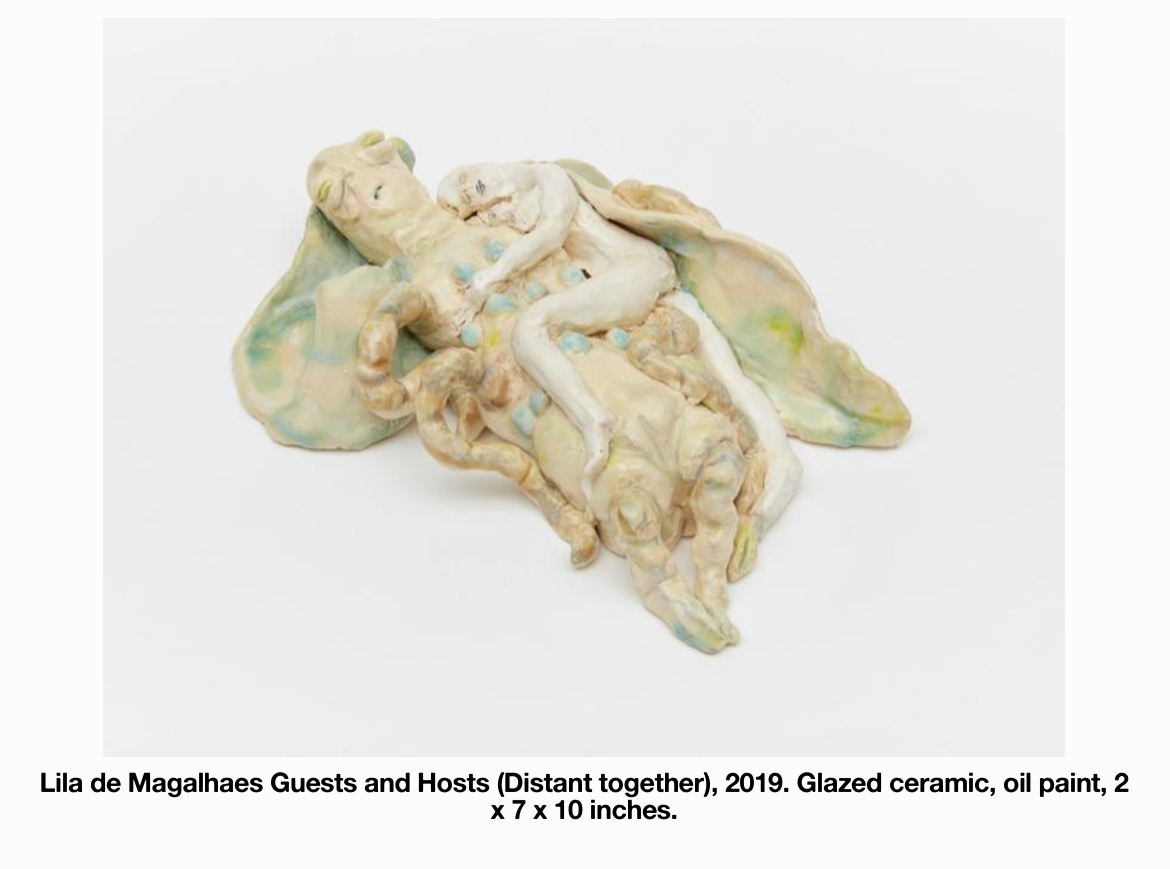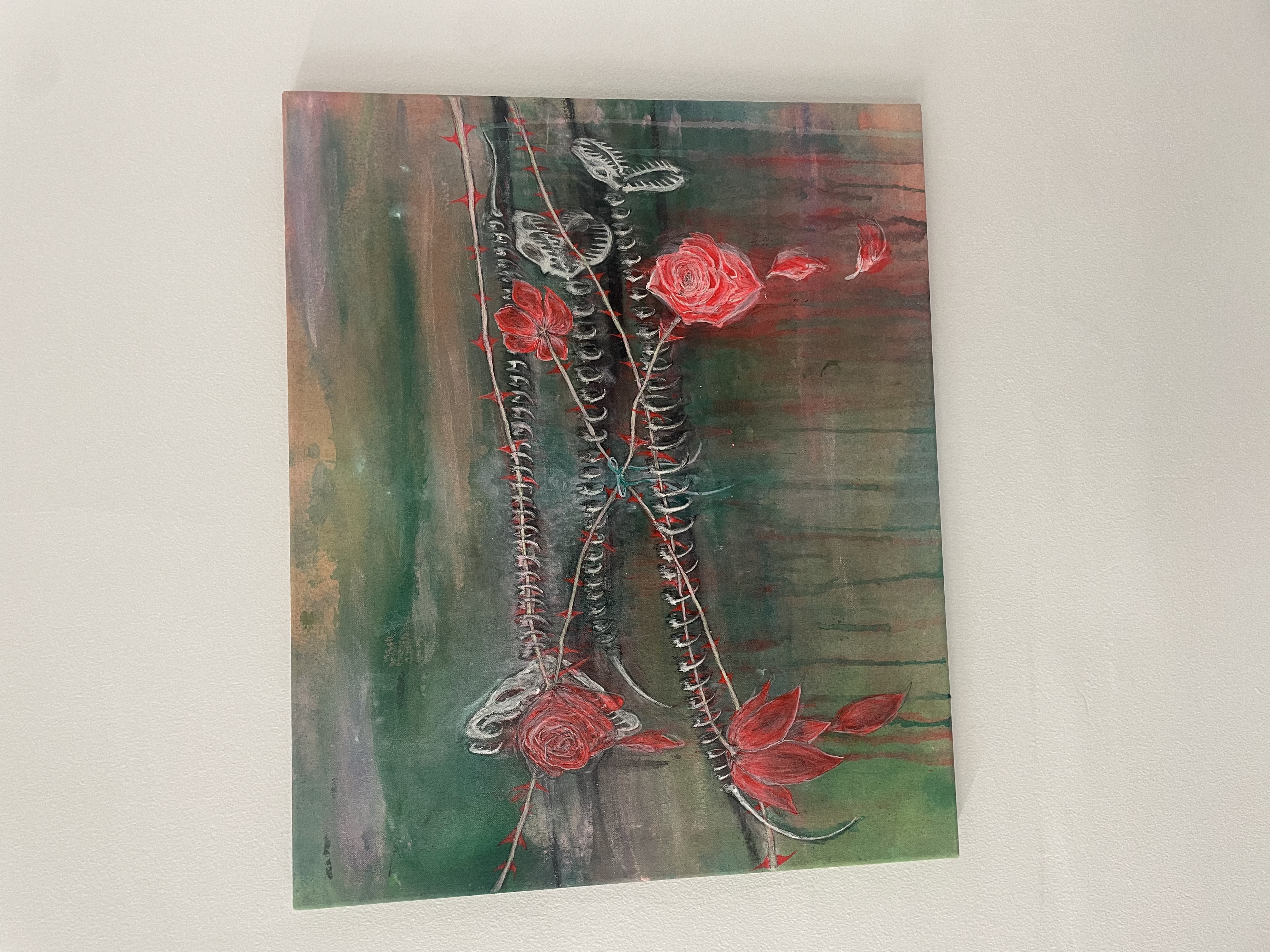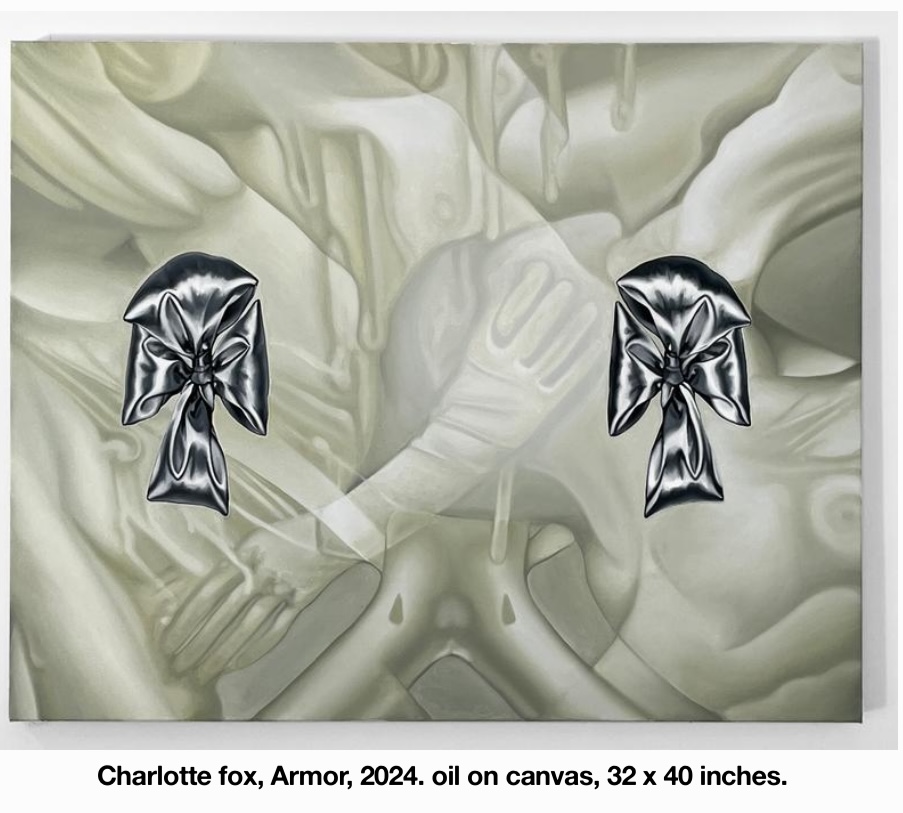fleshy, bloodied love
14 February 2024
Review
“I Think I’m in Trouble,” Tashi Fay, Charlotte Fox, Cecile Hirschler, Ellie Rae Hunter, Julien Parant-Marquis, Lila de Magalheas, Suzy Spence and Sophie Stone @ Sara’s
“Secrets to Graceful Living,” Anna Pedersón and Radimir Koch @ Alyssa Davis Gallery
—–__ (more eaze and seth graham) @ Roulette, February 10th
We live in the collapsing space between outstretched hands and unrealized desire. Empire is examining its own entrails. The dollar slice breakup costs $1.75. Industrial decay is the frontier of nostalgia. The present doubles back on itself to relive the traumas of four years ago. I bike in the 50 degree February coolness from Bushwick to Downtown Brooklyn to go to Roulette. I crisscross Greenwich Village, the West Village, and Chinatown to go to galleries.
The concept of abjection moves between these spaces. It is the sonic movement from intense emotional melody to crusted static screams. It is the delicate porcelain embrace of eviscerated lovers. It is the bloodied cuteness haunting the coquette gaze.
Abjection is felt in the moment where control invites unruliness. It is the turning inside out of lust where one’s craving becomes the thing that destroys them. In times haunted by the apocalypse, the turn to the abject feels natural. We live in the moment of our own undoing, so best to find some beauty in putrefaction.
In the duo show, “Secrets to Graceful Living,” artists Anna Pedersòn and Radimir Koch move between xenomorphic sculptures, tortured beadwork avatars, wry tributes to scene culture, and well springs for rotting lands. The show tracks alien forms across digital planes, familial places, and plastic gardens. Can we escape into any of these landscapes? Pedersôn’s Doomed Avi 1 and 2 showcase figures trapped under hovering helicopters and within dank prisons, yet both present curious smiles. Doomed Avi 1 clutches her purchases; Doomed Avi 2 almost eroticizes his imprisonment. Joy is a present given by embracing horrifying conditions. It is walking in and out of the luxury stores while protesters march through midtown. It is the coding of our emotional life within avenues for expression offered by contemporary capitalism.

I remember the emptiness of getting a dollar slice with a former partner, finding our imminent breakup inhabiting that floppy, doughy pizza. The February snow had piled up around Tompkins Square Park. The frosted beauty replaced by ice-caked mounds crawling with rats and infused with piss and sludge. The landscape of emotional collapse. Maybe this is where Radimir Koch’s Exo Relic and Mekhana try to find an escape from the colonization of our emotional life. As if excavating technologies from a different way of life, Koch presents a different synthesis of nature and culture. The forms of plants infuse designs. Eternal Pond 002 captures this fraying meeting point of alien technology and flowing water. But water is absent in the pond. Instead, it sits stagnant in the metastasization of what could have been.

We’re left with the bind of circumscribed joy and doomed alternatives. A bleak fork in the imagination. Psychoanalyst and philosopher Julia Kristeva identifies abjection as a fork within identity itself. It is the moment where the individual realizes that their sense of self is perpetually threatened by something outside of themself. How can we express love when the idea of love has been mediated by consumerism, structured by storytelling in film and television, and made self-aware by therapy? The struggle to establish the authentic self in love is abjection. The fear of our emotions being a false feeling of another’s imagination. Following Kristeva:
If it be true that the abject simultaneously beseeches and pulverizes the subject, one can understand that it is experienced at the peak of its strength when that subject, weary of fruitless attempts to identify with something on the outside, finds the impossible within; when it finds that the impossible constitutes its very being, that it is none other than abject. The abjection of self would be the culminating form of that experience of the subject to which it is revealed that all its objects are based merely on the inaugural loss that laid the foundations of its own being. There is nothing like the abjection of self to show that all abjection is in fact recognition of the want on which any being, meaning, language, or desire is founded.
This is the difficulty of love. The foundational want (for love) constitutes the subject in lack. But this is also the constitutive beauty of love. It is giving yourself to another to become yourself. At Sara’s group show “I Think I’m In Trouble”, this push and pull of love hovers over various pieces. Lila de Magalhaes’s Guests and Hosts (Distant Together) depicts two figures intertwined in love and death. There’s an ambiguity as to whether the two are locked in embrace or bound in a parasitic dance. Do the tubular forms represent the splayed insides of one figure becoming death or the avenues for interdependence between the two? The glazed ceramic shines in spite (or because?) of the grotesque.

Glistening, oozing, and bleeding–intermediary states flow throughout the show. Neither liquid nor solid, this motif captures the indeterminacy of abjection, of love, of the trouble that defines contemporary life. Cecile Hirschler’s Choking Up navigates snake skeletons snapping at roses. The running backdrop is a color field in decay that somehow still nourishes the roses. The painting reflects a complicated play between loss and desire as the death of the snakes does not eliminate their craving to consume the beauty of the roses. There’s an escape from the script of love. An embrace of the destruction that constitutes our own expression as the lived beauty of dying. Does it matter that we are the skeletal ouroboros? What if we tie a bow around the corpse?

Of course, there’s something unsatisfying about abandoning novelty. The ooze offers a different way to slither out of the bind. Charlotte Fox’s Armor slides between gloves, loves, bodies, and ooze. Identity is an impossibility in the play between figures. The viscous carnality suggesting it is the intensity of experience–of fucking–that abolishes the concern for how the self is constituted by something (or someone else). When you can’t tell whose sweat sticks to your skin, do you even care about anything else?

Contemporary fascination with the abject concerns the uneasiness with self-expression in a deeply mediated world. It confronts how to experience the authenticity and intensity of our emotions if our emotions aren’t our own. It is the horror of love that love is absolutely, overwhelming, and unbearably beyond our control. —–__, the audio-visual duo of more eaze and seth graham, exists in the unhinged self-annihilation and self-affirmation of the abject. Seamlessly moving between emotional autotuned pleas, harsh noise assaults, swells of violin, and reflective silences, the duo presents chaotic compositions that downplay virtuosity to emphasize drama. As more eaze’s vocals rise to confront the cacophony, there’s the unnerving realization that this beauty is always threatened by screeching feedback and shrill noise. This is the unsettled present of sitting with your emotions as the world screams at you. The performance confronts the floundering foundation of contemporary life with a confident embrace of the reality of feeling. What am I but my feelings? What am I but everything that makes me feel?
The music is joined by Graham’s videos surveying Midwestern parking lots, county fairs, and alleyways. The imagery focuses on the shimmer from the finish on cars, the ooze of gelatin, the drips of styrofoam cupped beverages, and the dust of dirt fairgrounds. The images of middle America don’t apply a moral framework of the forgotten everyman or the incalcitrant racist. Instead, these reflections, slimes, dripples, and particles dwell in the abjection of everyday feeling. There’s an unnerving acceptance that our emotions will have to be expressed in the language of late capitalism and a refusal to deny the intensity of them. Like Sean Baker’s Florida Project or Red Rocket, Graham’s videos leave us in the confused space between the fantasy of something beyond and the physicality of the mundane. The play between fantasy and reality is where the ooze subsists, an unformed sense of what could be. The pregnant present of our desires.
The world is composed of aches. An ache moves through the body, maybe stabilizing around a particular spot, but general in wearing one’s body down. The ache of love moves like an ooze, spreading from head to heart, consuming the lover in a pull to something beyond themself. Love rips people inside out, exposing the underlying ooze of flesh and blood. The valentine abject fluttering between fascination and disgust, our squishy bodies finding solidity in our emotions. And so the fears intrude: the fear of being too influenced by media and social norms, the fear of losing control of your emotions, the fear of caring too much for your emotions, the fear of death, the fear of your lover finding out your just a squishy sack of meat—the fear of love.
The abject in love is its simultaneous capacity to excite such intense fear and to inspire such intense courage. The beautiful contradiction of life: we live for other people.